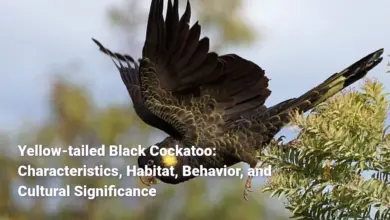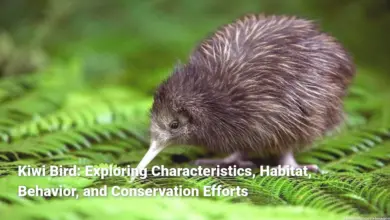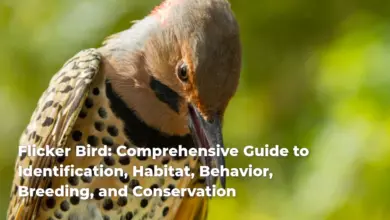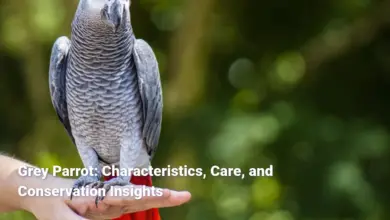Woodpecker Bird: A Complete Guide to Types, Habitats, Diet, and Behavior
A guide to Woodpecker species, their habitats, diets, and behaviors, with tips for attracting them to your garden.
Woodpecker Birds are among the most fascinating birds in the avian world, captivating bird watchers and nature enthusiasts alike with their remarkable adaptations and behaviors. These industrious creatures, easily identifiable by their vivid plumage, unique drumming sounds, and resilient nature, play crucial roles in forest ecosystems. With over 200 species scattered across continents, woodpeckers showcase a delightful range of colors, sizes, and behaviors that reflect their specialized adaptations to their habitats. From their famous drumming, which serves as both a communication tool and a mating call, to their remarkable foraging techniques, these birds embody a harmony of form and function.
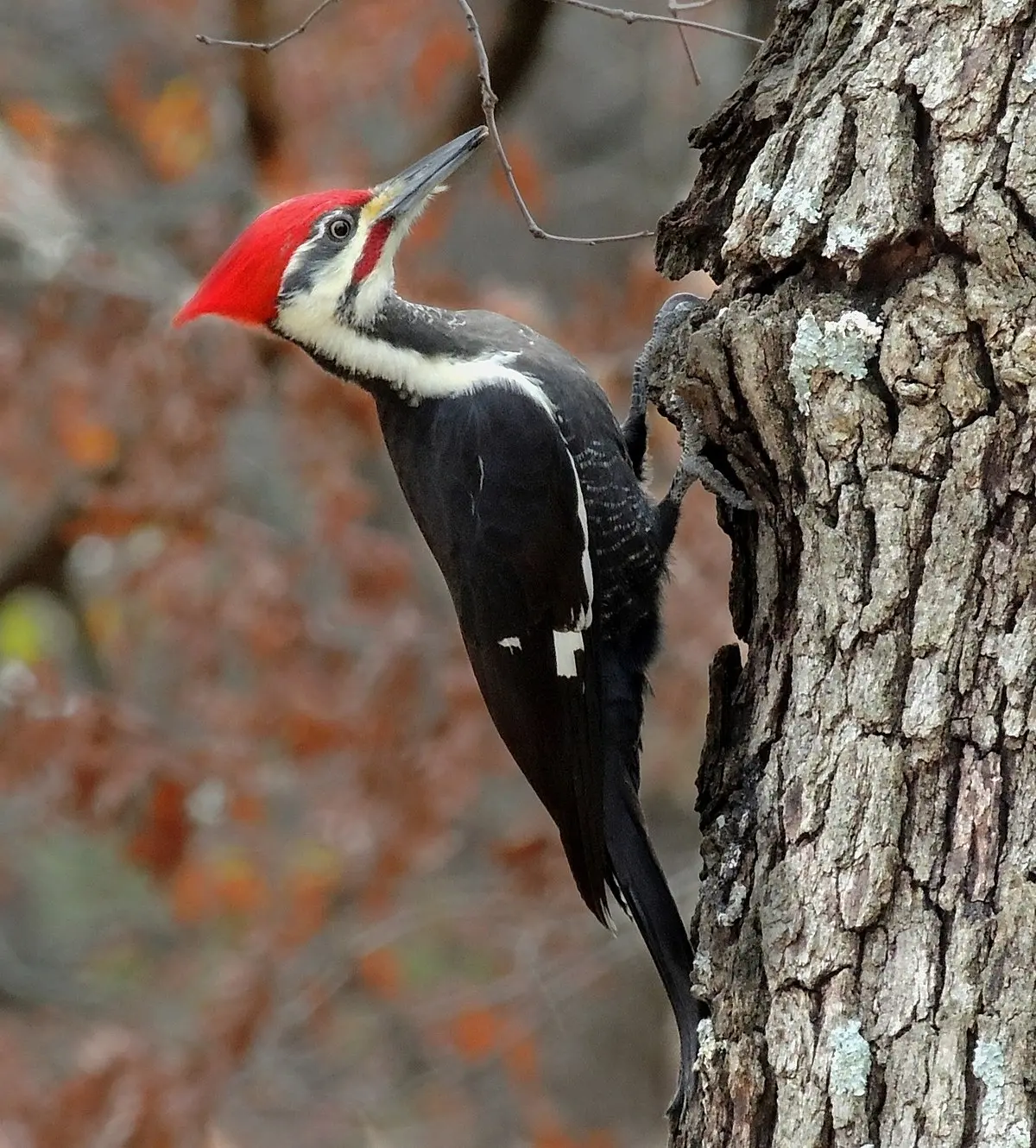
The woodpecker’s lifestyle is an enchanting blend of agility and endurance. As they climb and forage on tree trunks, their specialized anatomy allows them to tap into the hidden worlds of insects lurking beneath the bark. Their behavior not only provides sustenance but also leaves a mark on their habitats, creating cavities that benefit various other species. As we delve deeper into the captivating world of Woodpecker Birds, we will explore the diverse species, their habits, habitats, diets, breeding behaviors, and methods of attracting these magnificent birds to your backyard. Through this exploration, we aim to showcase not only the unique characteristics of woodpeckers but also their vital importance within the ecosystems they inhabit.
Types of Woodpecker Birds
Woodpecker Birdsbelong to the family Picidae, which encompasses a wide variety of species, each exhibiting unique characteristics and adaptations. The diverse types of woodpeckers can be compared to different genres of music; just as each genre has its distinct rhythm and style, so too do these birds possess unique features that set them apart.
Here is a look at some of the most notable types of woodpeckers:
| Woodpecker Species | Size | Habitat | Distinct Features |
|---|---|---|---|
| Downy Woodpecker | 15 cm (6 inches) | Forests, gardens | Small black-and-white plumage; males have a red patch. |
| Hairy Woodpecker | 25 cm (9.8 inches) | Deciduous and mixed forests | Checkered wings, square head, and straight bill. |
| Pileated Woodpecker | 40-49 cm (15.7-19.3 inches) | Mature forests, parks | Large size, striking black plumage with a bright red crest. |
| Northern Flicker | 28-30 cm (11-12 inches) | Open woodlands, suburbs | Tan face and vibrant plumage with distinct colors on wings. |
| Red-headed Woodpecker | 23-26 cm (9-10 inches) | Savannas, open woodlands | Vibrant red head and stark black back. |
Each species of woodpecker has adapted to meet the demands of its specific environment, influencing its size, habitat, and feeding behavior. For instance, the Downy Woodpecker is the smallest species found in the U.S., often favoring smaller branches and shrubs, while the Pileated Woodpecker’s larger size allows it to target substantial trees. This functional diversity extends to their colors, calls, and even nesting habits, reflecting the myriad adaptations Woodpecker Birds have developed over thousands of years.
As we explore these individual characteristics further, we will see how each woodpecker contributes to the overall biodiversity of its ecosystem, carving out niches that highlight their unique roles and ecological significance.
Downy Woodpecker
The Downy Woodpecker (Dendrocopos pubescens) is a delightful little bird that captures the hearts of many with its charming demeanor and striking appearance. Averaging around 15 cm (6 inches) long, it is the smallest woodpecker species in the United States, akin to a tiny acrobat performing amidst the towering branches. With its distinctive black-and-white plumage, featuring lighter spots on the wings and a small red patch on the back of the male’s head, the Downy Woodpecker exudes a gentle beauty that makes it a favorite among birdwatchers.
This active forager has an impressive ability to adapt to various environments, often seen hopping along branches or clinging to tree trunks in both urban gardens and dense forests. The Downy Woodpecker’s diet primarily consists of insects such as beetles and caterpillars, although it doesn’t shy away from seeds and berries during certain seasons. Its diminutive size allows it to reach food that may be inaccessible to larger woodpeckers, showcasing an imaginative approach to foraging.
| Key Characteristics | Description |
|---|---|
| Size | Approximately 15 cm (6 inches) |
| Diet | Insects, seeds, berries |
| Behavior | Active forager, agility in climbing and tapping |
| Habitat | Woodlands, gardens, parks across North America |
Despite their small size, Downy Woodpecker Birds pack a notable punch in terms of their ecological contribution. With an estimated population of around 13 million, these birds help control insect populations within their habitats, thereby maintaining the balance of local ecosystems. Their drilling behavior not only unveils food sources for themselves but also creates nesting cavities that may be used by other birds after they have fledged, making them essential contributors to biodiversity.
Although currently stable, the Downy Woodpecker faces potential threats from habitat loss and competition for nesting sites. Consequently, conservation efforts are vital in preserving their habitats and ensuring these enchanting little Woodpecker Birds continue to thrive in our forests and gardens.
Hairy Woodpecker
The Hairy Woodpecker (Leuconotopicus villosus) stands as a robust medium-sized woodpecker, measuring approximately 25 cm (9.8 inches) in length. With its characteristic black and white plumage, the Hairy Woodpecker can often be confused with its smaller cousin, the Downy Woodpecker. However, a closer look reveals features that set it apart, such as its larger size, squared head, and a long, straight bill nearly equal to the length of its head. Males flaunt a small red patch on the back of their head, maintaining a visual link to their species’ identity.
| Feature | Description |
|---|---|
| Identification | Medium-sized, contrasting black and white plumage |
| Size | Approximately 25 cm (9.8 inches) |
| Diet | Wood-boring beetle larvae, ants, nuts, and berries |
| Habitat | Deciduous and mixed forests, urban parks |
Hairy Woodpecker Birds are highly adaptable, occupying a vast range of habitats, including deciduous forests and suburban parks, where they forage for food. Their feeding technique primarily involves drilling into tree trunks and foraging for underlying wood-boring larvae, showcasing the dexterity of their strong beaks and long tongues. While foraging, these woodpeckers often create characteristic holes that benefit other species by providing new nesting sites.
The Hairy Woodpecker’s drumming behavior is not just a means of establishing territory but also forms a crucial part of their courtship rituals. Their proficient drumming can establish dominance and attract mates, creating a delightful orchestra of sounds within the forests.
Both male and female Hairy Woodpecker Birds participate in nesting, excavating cavities in dead or decaying trees, where they lay an average of five to six eggs. The parents share the incubation duties, which last from 10 to 14 days, after which the altricial chicks are cared for until they fledge.
With an estimated population of around 8.5 million in North America, the Hairy Woodpecker is considered to be stable, though habitat loss and human activity can impact their numbers. Protecting and preserving their woodlands is essential for maintaining this robust species that plays a vital role in forest ecosystems.
Pileated Woodpecker
The Pileated Woodpecker (Dryocopus pileatus) is an iconic and striking figure amidst North American Woodpecker Birds, often likened to a miniature dinosaur due to its sizable frame and distinctive features. This large woodpecker measures between 40-49 cm (15.7-19.3 inches), boasting a vibrant black plumage peppered with white stripes down its neck and a brilliant red crest that stands in stark contrast. Its size is impressive; much like a crow, the Pileated Woodpecker commands attention both visually and audibly.
These Woodpecker Birds thrive in mature forests and are particularly adept at navigating their habitats. They prefer areas rich in dead and decaying wood, as these spaces provide abundant food sources and suitable nesting sites. Pileated Woodpeckers mainly feed on carpenter ants and wood-boring beetle larvae, using their powerful beaks to excavate large, rectangular holes in trees. This behavior not only facilitates their feeding habits but also shapes their habitat, creating spaces that benefit other wildlife species.
| Key Characteristics | Description |
|---|---|
| Size | 40-49 cm (15.7-19.3 inches) |
| Habitat | Mature forests, suburban areas with large trees |
| Diet | Carpenter ants, wood-boring beetle larvae |
| Behavior | Loud calls, distinctive drumming, monogamous |
The behavior of Pileated Woodpecker Birds during breeding season is equally captivating. These birds are known for their distinctive calls, which can echo throughout the forest, announcing their presence and helping to establish territory. Pileated Woodpeckers are monogamous, and both parents work jointly to create nesting cavities approximately 15-20 meters (50-66 feet) up in large trees. After the female lays an average of three to five eggs, both parents cooperate in incubating and feeding the young until they are ready to fledge.
With an approximate population of 2.6 million, Pileated Woodpeckers are considered stable, but they are affected by habitat loss due to logging and development. Therefore, forest conservation initiatives are crucial to the survival of these magnificent Woodpecker Birds, which not only enrich our forests with their presence but also significantly contribute to ecosystem diversity.
Northern Flicker
The Northern Flicker (Colaptes auratus) presents a delightful contrast to the typical imagery of Woodpecker Birds drilling against tree trunks. Measuring around 28-30 cm (11-12 inches), this woodpecker is distinctive with its brown plumage adorned with spots and a notable black “mustache” mark in males. Unlike many woodpecker species, Northern Flickers are unique for their foraging behavior, often hunting on the ground for ants and beetles, a practice that sets them apart from their tree-climbing relatives.
This species showcases two main forms: the Yellow-shafted Flicker, primarily found in the Eastern United States, and the Red-shafted Flicker, which is located in the West. Each form displays unique coloration, with the Yellow-shafted Flicker exhibiting a tan face and gray crown, while the Red-shafted Flicker boasts vibrant red wing and tail shafts observable during flight.
| Species Variant | Description |
|---|---|
| Yellow-shafted Flicker | Tan face, gray crown, red nape, spotted belly (Eastern U.S.) |
| Red-shafted Flicker | Gray face, brown crown, red mustache (Western U.S.) |
Northern Flickers are known for their varied diet, predominantly consisting of ants, which they skillfully unearth from the ground. This adaptation to ground foraging allows them to exploit food sources often overlooked by other woodpecker species. Interestingly, they also demonstrate nutritional flexibility, consuming seeds and fruits when insects are less abundant.
During the breeding season, Northern Flickers exhibit a variety of vocalizations and drumming behaviors to attract mates and fend off competitors. Their nests are typically excavated in trees or utility poles, benefiting greatly from the availability of dead wood for nesting. The female typically lays around four to seven eggs, which both parents incubate and care for until the chicks successfully fledge.
The population of Northern Flickers is stable, but habitat loss and urbanization can impact local populations. Thus, maintaining healthy forests with sufficient ground cover and dead trees is vital for supporting this unique woodpecker species.
Red-headed Woodpecker
The Red-headed Woodpecker (Melanerpes erythrocephalus) is a striking bird, immediately recognizable by its vibrant red head, stark black back, and white underparts. This medium-sized woodpecker, measuring between 23-26 cm (9-10 inches) in length, captures attention wherever it travels, embodying the aesthetics of the forest. While adults flaunt their dazzling coloration proudly, juvenile red-headed Woodpecker Birds present a more muted, brownish appearance, making the transformation to adulthood all the more remarkable.
The Red-headed Woodpecker thrives in varied habitats, including open woodlands, savannas, and areas with a mix of trees and open ground, allowing foraging opportunities. This species demonstrates an impressive versatility; it is equally adept at drilling into trees for insects and foraging on the ground for nuts, seeds, and even fruits. This dual-foraging behavior enables them to adapt to changing food availability.
| Characteristics | Description |
|---|---|
| Coloration | Vibrant red head, neck, and throat; black wings and back |
| Diet | Insects, seeds, nuts, ground foraging |
| Habitat | Open woodlands, savannas, suburban areas |
One of the most intriguing aspects of Red-headed Woodpecker behavior is their penchant for food storage. Unlike many of their woodpecker relatives, they often stash food in tree crevices, a skill that showcases their resourcefulness. This can be particularly valuable during tougher months when food sources dwindle.
While the Red-headed Woodpecker was once abundant, populations have declined due to habitat loss, primarily caused by land development and changes in agricultural practices. Despite their struggles, these striking birds remain a favorite among birding enthusiasts, admired for their elegance and unique foraging behaviors.
Woodpecker Bird Habitats
Woodpecker Birds are primarily found in forested environments, where they thrive within ecosystems rich in biodiversity. Their habitats can range from temperate forests to tropical rainforests, each offering unique resources essential for their survival. Just as a symphony is composed of various instruments, woodpecker habitats feature a diverse array of plant species that create a harmonious setting for these birds to thrive.
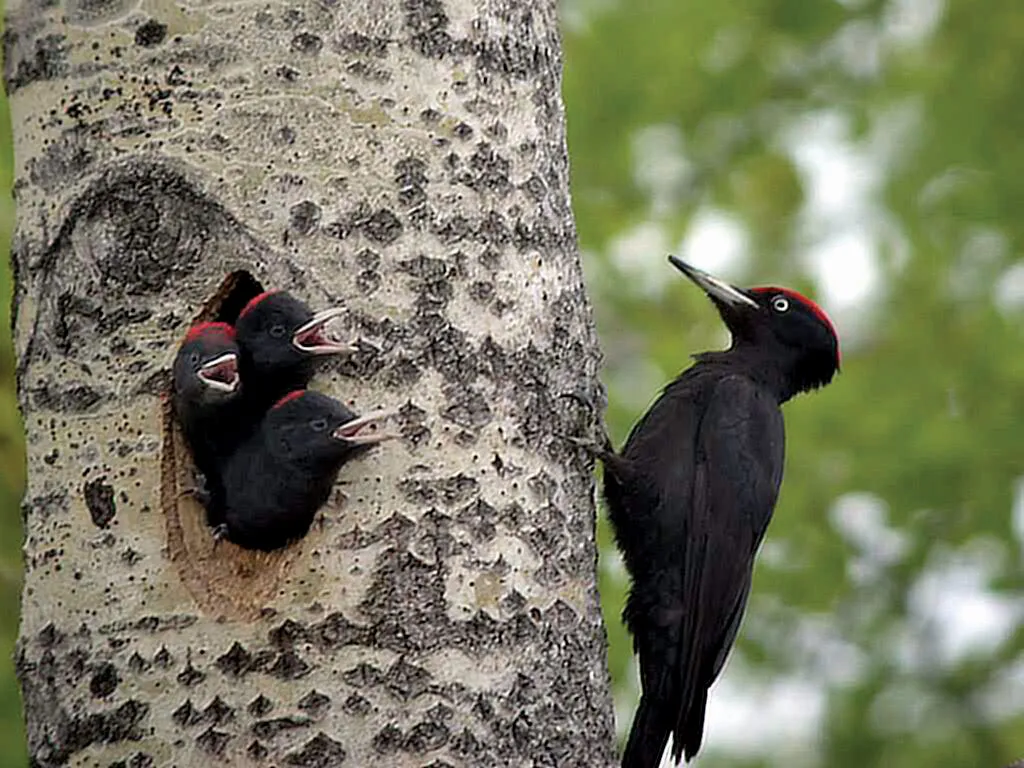
Preferred Habitats
Drawing on this symphonic metaphor, the preferred habitats of Woodpecker Birds can be summarized as follows:
| Habitat Type | Description |
|---|---|
| Deciduous Forests | Rich in hardwoods, providing abundant insects and nesting sites |
| Mixed Forests | A combination of deciduous and coniferous trees, offering a variety of foraging opportunities |
| Urban Areas | Parks and gardens with mature trees serving as habitat pockets |
| Savannas | Open spaces with scattered trees, suitable for ground-foraging species |
Woodpecker Birds exhibit a preference for habitats with plenty of dead and decaying wood, which serves as both a source of food and a suitable nesting site. The presence of such trees indicates ecological maturity in forests, emphasizing the need to protect these crucial environments.
Tree Characteristics
The type of trees found within these habitats is essential for woodpecker survival. Dead and decaying trees, often referred to as snags, provide critical insect habitats while also allowing woodpeckers to excavate cavities for nesting. This process benefits other bird species as well; many cavity-nesting birds rely on abandoned woodpecker holes for their own nesting sites.
Cavity Nesting
Woodpecker Birds are unique among avian families due to their habit of cavity nesting. The cavities they excavate are vital not only for their breeding but also for maintaining forest biodiversity. This process helps to ensure other birds and small mammals have spaces to inhabit, thus supporting a broader range of wildlife.
Incorporating these elements together showcases the importance of these habitats, as they form the crucible for woodpecker lifestyles and behaviors. By maintaining a diverse mix of tree species, ensuring a supply of deadwood, and protecting forested areas, we can savor the contributions of woodpeckers and the richness they offer within their ecosystems.
Urban Adaptation
While Woodpecker Birds traditionally rely on forested areas for habitat, many species have shown a remarkable ability to adapt to urban environments. As urbanization continues to expand, understanding the dynamics behind woodpecker adaptation becomes crucial to the conservation of these birds.
Urban Adaptation and Habitat Use
Woodpecker Birds that thrive in urban environments often do so due to specific attributes of those spaces. The coexistence of urban parks, gardens, and wooded yards can provide rich resources for these birds. For instance, areas with mature trees that provide suitable bark for foraging or decaying wood for nesting become crucial habitats for urban woodpeckers.
Species-Specific Habitat Preferences
Different woodpecker species exhibit varying preferences for urban habitats. Research indicates that certain urban woodpecker populations flourish when ample resources, such as food and nesting sites, are available. Factors such as the presence of native tree species, canopy cover, and shrub density can significantly influence the richness of woodpecker populations within urban settings.
| Factors | Influence on Woodpecker Presence |
|---|---|
| Woodland Patch Area | Larger patches can support higher woodpecker diversity |
| Tree Species Variety | More diverse species provide better food and nesting opportunities |
| Canopy Openness | Affects foraging efficiency and predator avoidance |
Impact of Urbanization
As urban areas develop and habitats are altered, woodpeckers may struggle with decreased availability of natural sites for nesting and foraging. Fragmentation caused by construction and increased competition further challenges these resilient birds. Maintaining green spaces and integrating natural habitats into urban planning is vital to support these altered woodpecker populations.
By ensuring urban environments maintain sufficient tree cover and incorporating nesting opportunities, we can provide essential habitats for woodpeckers while fostering greater biodiversity within our cities.
Woodpecker Bird Diet
Woodpecker Birds exhibit a diverse diet, primarily relying on insects while also incorporating a variety of plant materials. Their feeding habits reflect both adaptability and resourcefulness, mirroring the complexities of nature itself.
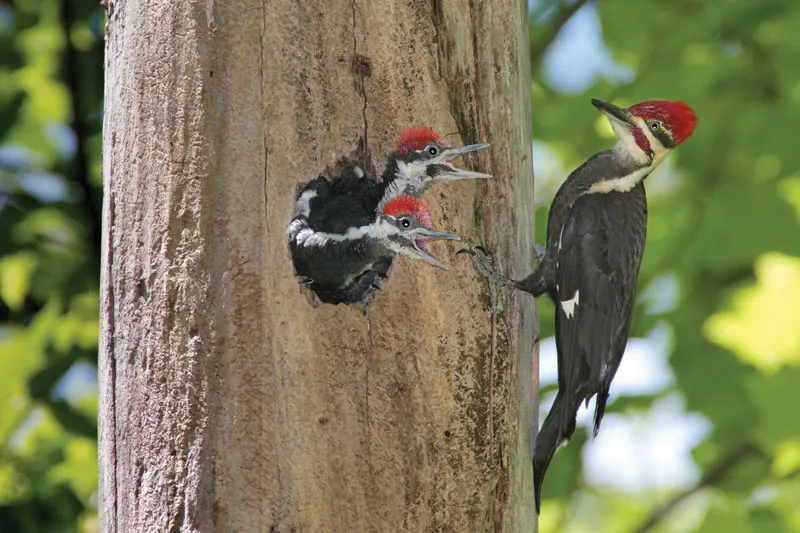
Diet Components
The diet of Woodpecker Birds can be segmented into different components that showcase their feeding behaviors:
| Food Source | Description |
|---|---|
| Insects | Key components include ants, beetles, and caterpillars, often found hidden beneath tree bark. |
| Plant Matter | Woodpeckers consume fruits and nuts, providing essential energy and nutrients. |
| Nuts and Acorns | Important for fat content, especially during colder months. Some species cache food for later use. |
| Tree Sap | Certain species, like the Yellow-bellied Sapsucker, depend on tree sap as a food source during specific seasons. |
Each species exhibits unique foraging behaviors adapted to their lifestyles and environmental needs. From the Ground-foraging abilities of the Northern Flicker to the drilling habits of the Pileated Woodpecker, each adaptation highlights the intricate dance of survival within ecosystems.
Insectivorous Diet
Primarily insectivorous, Woodpecker Birds target various insects that live within trees, which are often difficult for other animals to access. This focus on hidden fauna helps control pest populations while simultaneously nourishing the woodpecker species.
Woodpecker Birds are equipped with strong, pointed beaks that allow them to perforate bark and hollows in trees, revealing nutrient-rich larvae and beetles. Their long, sticky tongues are well-suited for extracting insects from their hiding places.
The feeding choices of woodpeckers are influenced seasonally by the availability of food resources, increasing their importance as natural pest controllers.
Plant Material Consumption
In addition to insects, plant materials form an essential part of many woodpecker diets. This varied approach ensures sufficient energy and nutrients, especially during transitions between seasons.
Fruits and Nuts
Woodpecker Birds are known to consume various fruits such as berries and cherries during summer, benefiting from the nutritional value they provide as they prepare for breeding and autumnal foraging. They also enjoy nuts and acorns in fall, utilizing these energy-dense food sources to sustain themselves through winter.
Tree Sap
Certain woodpecker species possess specialized adaptations to feed on tree sap. The Yellow-bellied Sapsucker, for example, drills small holes into trees, creating sap wells from which it can drink. This behavior not only sustains its diet but can also contribute to tree health by allowing for sap to leak, which attracts more insects.
Seasonal Dietary Changes
Woodpecker diets undergo seasonal transformations in response to changes in food availability:
| Season | Dietary Focus |
|---|---|
| Spring | Emphasis on tree sap and newly emerging insects |
| Summer | Largest intake of insects for protein during breeding |
| Fall | Transition to seeds, nuts, and leftover fruits |
| Winter | Dependence on stored food and reliance on high-energy sources like nuts |
These adaptive strategies illustrate how woodpeckers survive and thrive within ever-changing environments. As primary insectivores, their ability to adjust dietary habits throughout the seasons reflects their resilience and ecological significance.
Woodpecker Bird Behavior
The behaviors displayed by Woodpecker Birds showcase their unique adaptations to their environments, particularly when it comes to foraging, drumming, and social interactions. Each behavior plays a significant role in their survival and contributes to the dynamic of forest ecosystems.
Foraging Techniques
Woodpecker Birds exhibit a copious array of foraging techniques to find food. The primary methods include:
| Technique | Description |
|---|---|
| Drilling and Hammering | Utilizing strong beaks to access insects in wood. |
| Probing | Inserting beaks into crevices for deeper access to food. |
| Ground Foraging | Some species search for ants and beetles on the soil surface. |
These methods are tailored to each species and depict their unique adaptations to varied habitats. For example, while the Hairy Woodpecker excels at extracting larvae from tree trunks, the Northern Flicker targets ground insects. This diversity in behavior helps woodpeckers avoid competition for resources and stresses the complexity of their feeding habits.
Drumming and Vocalizations
Drumming is a hallmark behavior for woodpeckers, serving multifaceted roles. It acts as a means of communication, territory establishment, and mating courtship:
| Context | Purpose |
|---|---|
| Territorial Display | Drumming signals boundaries to other woodpeckers |
| Mate Attraction | Auditory display fascinates potential mates |
| Communication | Facilitates social interactions within groups |
The intricate patterns they drum on various surfaces are not only unique to each species but also encode specific information regarding their identity and social status. This specialized form of communication emphasizes the cognitive abilities and social behaviors present in woodpeckers.
Social Interactions
Social behaviors further highlight the complexities of woodpecker lives. Their interactions can take various forms, including competition, bonding, and parental cooperation. Studies reveal that many woodpecker species exhibit remarkable adaptability when forging social relationships and responding to environmental challenges.
In many instances, male woodpeckers will engage in courtship displays, showcasing their strength through vigorous drumming and eye-catching acrobatics. These rituals not only attract mates but can also determine territory boundaries among competing males. Equally, during the breeding season, both parents collaborate in nesting duties and raising their young, exemplifying cooperation that develops between the sexes.
By understanding woodpecker behavior, we gain insights into their roles within their ecosystems, the delicate networks of interactions they inhabit, and the evolutionary adaptations that have allowed them to thrive in various environments.
Woodpecker Bird Reproduction
Woodpecker reproduction is a fascinating aspect of their biology, characterized by unique nesting habits, courtship displays, and parental care that ensure the continuation of their species.
Nesting Habits
Upon the arrival of spring, woodpeckers typically enter the breeding season, with most species laying eggs between April and July. Here are key components of their nesting behavior:
| Aspect | Description |
|---|---|
| Nesting Structure | Excavation of cavities in dead trees |
| Egg-Laying | Clutch sizes typically range from 3 to 10 eggs |
| Incubation | Shared between male and female for 10-18 days |
Woodpecker Birds display remarkable dedication to their nest construction, often choosing trees that are decaying or dead. This marked preference is essential for the safety of their eggs, as such trees are often less accessible to predators.
Courtship Displays
Courtship dynamics among woodpeckers are fascinating, incorporating complex behaviors that help establish bonding between pairs:
| Display Type | Description |
|---|---|
| Drumming Performances | Males produce rhythmic drumming to attract females |
| Vocalizations | Calls used between partners for communication |
| Feeding Gestures | Mutual feeding strengthens pair bonds |
These courtship displays serve multiple purposes: signaling fitness, establishing territory, and fostering connections between potential mates. This dedication not only reinforces pair bonds but also encourages collaboration in child-rearing.
Parental Care
Parental care in woodpeckers includes shared responsibilities after the eggs hatch:
| Care Aspect | Description |
|---|---|
| Shared Responsibilities | Both parents feed and protect the chicks |
| Incubation Duties | Approximately 10 to 18 days of shared incubation |
| Post-Fledging Support | Young stay nearby as they learn essential survival skills |
After hatching, the chicks remain dependent on their parents for nutrients and safety. This joint effort allows for the successful nurturing of the young woodpeckers until they reach independence.
Through these detailed reproductive behaviors, we learn how critical woodpecker parenting is to maintaining healthy populations. The intricate balance of cooperation and duties showcases the remarkable adaptive strategies that enable these birds to thrive in diverse environments.
Attracting Woodpecker Birds
Attracting woodpeckers to your backyard can bring unparalleled joy to birdwatchers and naturalists alike. By implementing measures that cater to their needs, you can create an inviting habitat for these captivating birds.
Backyard Feeding Stations
To successfully attract woodpeckers, focus on the following food sources:
| Food Type | Description |
|---|---|
| Suet | A preferred food source, especially during colder months |
| Seeds and Nuts | Black-oil sunflower seeds and raw peanuts are favorites |
| Mealworms | Live or dried mealworms provide high protein diet |
| Other Foods | Fruits like oranges in warmer months |
These food sources need to be placed in appropriately designed feeders to maximize accessibility for woodpeckers while deterring larger, more aggressive birds.
Suitable Nesting Sites
Creating suitable nesting sites is crucial for attracting woodpeckers into your yard:
| Nesting Type | Description |
|---|---|
| Dead Trees (Snags) | Holding onto dead trees enhances natural nesting opportunities |
| Birdhouses | Installing birdhouses that mimic natural cavities can be effective |
| Tree Species | Providing mature trees that can host nests, such as oaks or pines |
By fostering a habitat rich in the necessary resources for nesting, you encourage woodpeckers to stay and breed in your yard.
Providing Natural Foraging Habitats
Beyond feeders and nesting sites, fostering natural foraging opportunities is essential for drawing woodpeckers into your environment:
| Habitat Features | Description |
|---|---|
| Insect Habitats | Allow areas of decaying wood to remain for attracting insects |
| Diverse Tree Planting | Creating a mix of tree species to serve food resources |
| Natural Cover | Incorporating shrubs and underbrush for safety while foraging |
By incorporating these components into your backyard, you can create a woodpecker-friendly environment that supports these birds throughout the changing seasons.
Overall, attracting woodpeckers to your property enriches your experience with nature while supporting the survival of these vital species within their ecosystems.
Through this journey of discovery, we have explored the intricate lives of woodpecker species and the rich diversity they represent within the avian world. From their unique diets and behavior patterns to their meaningful roles in ecosystems, woodpeckers are a testament to the beauty and complexity of life that exists in our forests and gardens. Adapting to changing environments, these birds are remarkable not only for their captivating appearances but also for their functional importance in the delicate web of biodiversity. Their presence enriches our natural habitats, and efforts to understand and protect them can contribute to a healthier world for wildlife and humans alike.






